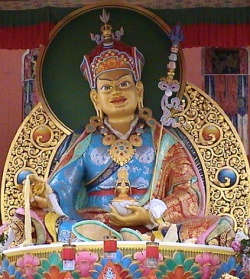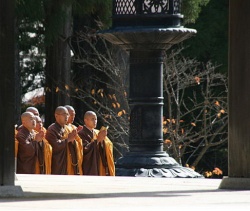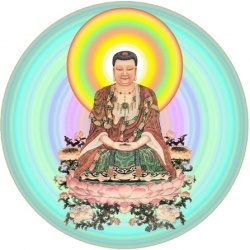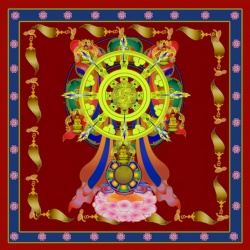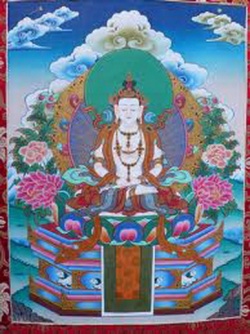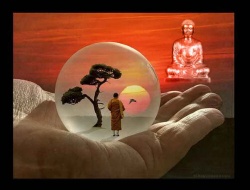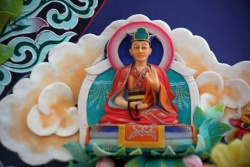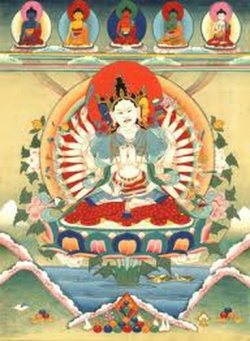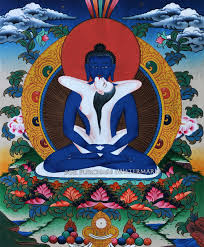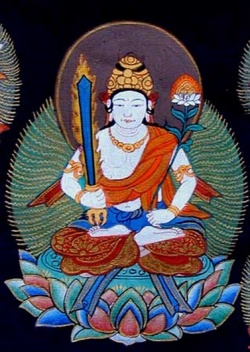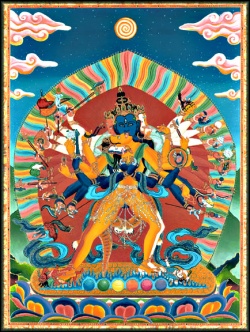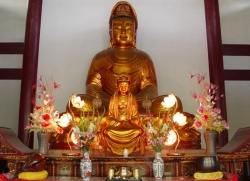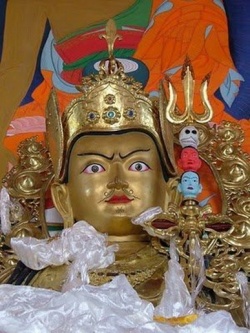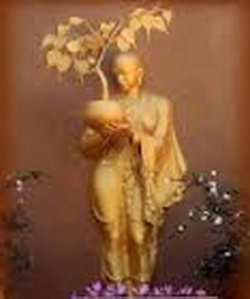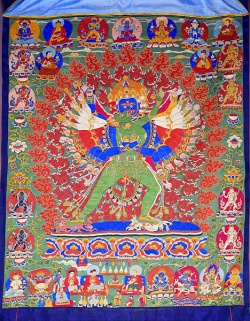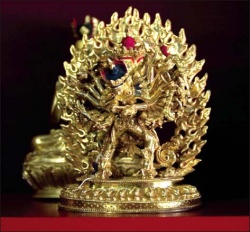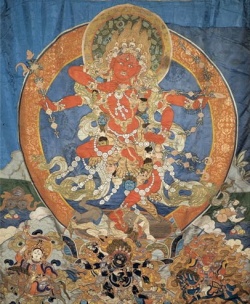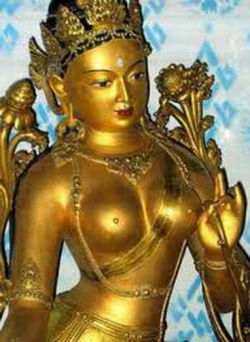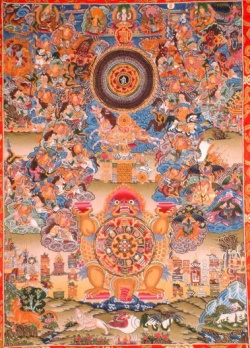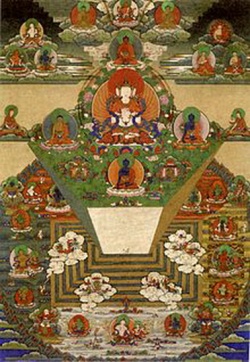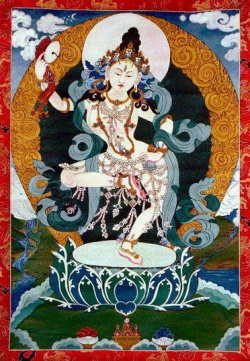Empowerment
Empowerment (Skt. abhiṣeka or abhiṣiñca; Tib. དབང་, wang; Wyl. dbang) is the initiation that transmits or awakens primordial wisdom (Tib. ཡེ་ཤེས་, yeshe), the power or realization in the mind of the disciple.
Empowerment is very important, for in order to practice tantra, one must first receive initiation. In the lower categories of tantra, there is only the vase initiation.
Empowerment (Tib.{{BigTibetan|དབང་, Wyl. dbang, wang) refers to the Vajrayāna ritual which awakens the special capacity for primordial wisdom (Tib. yeshe) to arise in the mind of the disciple. It is called 'empowerment' because when we receive it, we are empowered to follow a particular spiritual practice, and so come to master its realization.
It is said:
In the Secret Mantra Vehicle, there can be no accomplishment without empowerment,
For that would be like a boatman without oars.
Without empowerment there's no accomplishment;
You can't get oil from pressing sand.
Empowerments can only be granted by qualified vajra masters and require for the students receiving them to maintain the specific vajrayāna precepts (Skt. samaya), on the basis of the refuge and bodhisattva vows.
Dzongsar Khyentse Rinpoche reminds us of the real meaning of 'empowerment':
"The most common description of abhisheka is that it is a transfer of power during a ceremony to give recipients the authorization to hear, study and practice the teachings of the vajrayana; we therefore “receive an empowerment.”
But the problem is that receiving an empowerment suggests someone is giving us a power we previously lacked[...], and is a long way away from the true spirit of tantric initiation.
During an initiation we are introduced to an aspect of ourselves that already exists within us but that we have yet to recognize, and it is the activation of this recognition that we call 'empowerment' or 'initiation'. This is the real meaning of abhisheka.
Oral transmission (Tib. ལུང་, lung; Wyl. lung; Skt. āgama) — It is important to receive an oral transmission (sometimes called 'aural transmission' or 'reading transmission') from a teacher, in order to create an auspicious connection with a particular text or practice. In the case of tantric texts, such as sādhanas or commentaries, this transmission occurs once one has received the relevant empowerment.
The reading transmission is passed down from master to student when the student listens to the teacher reading a text for which he or she holds a transmission, ultimately going back to the author of the text.
In this way, the student receives the blessing of the lineage without which he or she will not be able to understand the text fully in all its depth. Some teachers even consider it inappropriate to look at and read a dharma text for which one has not yet received a transmission.
In the two higher categories of tantra, there are four initiations:
the vase,
secret,
wisdom, and
word initiation (or oral empowerment).
From the moment a practitioner has taken the vase initiation, the master bestowing it becomes his or her lama. Within the vase initiation there are several initiations, each related to the five Buddha families: Akshobya, the water initiation; Ratnasambhava, the crown initiation; Amitabha, the vajra initiation; Amoghasiddhi, the bell initiation; and Vairochana, the name initiation.
In addition, there is also the master initiation.
The lama bestowing the initiation is called the vajra-master.
Receiving initiation from a qualified master is a permission to recite the text(s), to meditate on the deity, and to recite the deity’s mantra.
Without an initiation the practice of tantra is not only not permitted, but is also considered a cause for accumulation of grave negative karma for both the teacher and the disciple. Receiving the proper initiation gives the practitioner power to practice successfully and gain accomplishments.
As stated in the following verse:
Without initiation there is no spiritual attainment,
Like a butter-lamp of water.
Once the disciple has received initiation, the lama can teach him or her tantric practices and meditations.
Having received initiation into the three lower tantras, the disciple must practice the yoga with signs, which means visualizing the deity and reciting the mantra(s), which are practices for developing a calmly abiding mind.
Once calm-abiding has been attained, the disciple practices the yoga without signs, which is meditation on emptiness, with meditation on the deity to develop special insight. Having received the higher tantric initiations, the disciple is ready to practice the generation and completion stages.
empowerment (jiachi):
Empowerment (Tib.: wang kur): a formal and often complex initiation into a specific practice of deity yoga, using a mandala, and lasting from 1 to 3 days.
What one receives from outer or inner-tantric initiation given by an authentic vajra master.
However, Dorje Chang Buddha III has told us that showing loving-kindness toward all living beings and understanding and believing in the law of cause and effect is better than all types of empowerment. Literally means added support
Subcategories
Tulku Thondup explains that among the different ways of categorizing empowerments:
- empowerments given to disciples who have not been initiated before are called causal empowerment;
- the empowerment given to students for developing their maturation or restoring the broken precepts are classified as empowerment of the path; and
- empowerments given to those who are ready to achieve the final attainment and which cause the disciple to attain the ultimate fruition are classified as empowerments of result because they bring the final result.[1]
See also the four empowerments.
The Function of Empowerment
Empowerment is to ripen or mature our buddha nature.
Even though all beings possess the buddha nature, without receiving empowerment it is not possible to receive blessings and accomplishments through a particular practice, just as it will never be possible to get oil by pressing sand.
His Holiness the Dalai Lama says:
- "When an empowerment is conferred on you, it is the nature of your mind—the buddha nature—that provides a basis upon which the empowerment can ripen you.
Through the empowerment, you are empowered into the essence of the buddhas of the five families.
In particular, you are ‘ripened’ within that particular family through which it is your personal predisposition to attain buddhahood."
Two Causes & Four Conditions
Two Causes
- The cooperative cause (lhan cig byed pa'i rgyu) is the use of various substances (rdzas) during the empowerment, such as the vase, image cards and so forth.
Four Conditions
- The causal condition (rgyu'i rkyen) is the disciple who has faith and intelligence
- The dominant condition (bdag rkyen) is the teacher who is fully qualified
- The objective condition (dmigs rkyen) is the teacher's knowledge of the empowerment, deities, and mantras, and samadhi
- The immediate condition (de ma thag rkyen) is the previous phase or empowerment, since each phase prepares the student for what follows, and that is why empowerments must be given in the proper sequence[2]
- Chögyam Trungpa Rinpoche, Journey Without Goal, The Collected Works of Chögyam Trungpa, Volume Four (Boston & London: Shambhala, 2003), Ch. 10 'Abhisheka'.
- Herbert V. Guenther, The Dawn of Tantra, The Collected Works of Chögyam Trungpa, Volume Four (Boston & London: Shambhala, 2003), Ch. 9 'Empowerment and Initiations'.
- His Holiness Dilgo Khyentse Rinpoche, Pure Appearance (Halifax: Vajravairochana Translation Committee, 1992, 2002—restricted title), pages 1-14.
- Jamgön Kongtrul, The Treasury of Knowledge, Book Six, Part Four: Systems of Buddhist Tantra, translated by Elio Guarisco and Ingrid McLeod (Ithaca: Snow Lion, 2005), Ch. 12 'Initiation'.
- Padmasambhava & Jamgön Kongtrul, The Light of Wisdom, Vol. Two, translated by Erik Pema Kunsang (Boudhanath: Rangjung Yeshe Publications, 1999), Chapter 16.
- Thinley Norbu, The Small Golden Key (Shambhala Publications, 1999), '12. Empowerment'.
- Tsele Natsok Rangdrol, Empowerment and the Path of Liberation, Rangjung Yeshe Publications, 1993.
- Tulku Thondup, Enlightened Journey: Buddhist Practice as Daily Life (Boston: Shambhala, 1995), 'The Empowerments and Precepts of Esoteric Training', pages 106-133.
See Also
Empowerment (dbang)
The conferring of power or authorization to practice the Vajrayana teachings, the indispensable entrance door to tantric practice.
Empowerment gives control over one's innate vajra body, vajra speech and vajra mind and the authority to regard forms as deity, sounds as mantra and thoughts as wisdom.
Empowerment
A special potential power to attain any of the four Buddha bodies that is received by a Tantric practitioner from his or her Guru, or from other holy beings, by means of Tantric ritual.
The gateway through which we enter Tantra is receiving a Tantric empowerment, which bestows upon us special blessings that heal our mental continuum and awaken our Buddha nature.
When we receive a Tantric empowerment, we are sowing the special seeds of the four bodies of a Buddha upon our mental continuum.
See also 'four empowerments.'
"Various medicines have various types of strength or power.
Water has a power to wet things and clean things.
Fire has a power to burn.
When we put water in a field it helps to grow flowers or crops.
All phenomena have a particular power associated with them.
Through the power of interdependence, when we ask for the blessing, blessing comes as a particular type of power.
One receives that power, the blessing, and one's defilements and obscurations are purified and dispelled."
Initiation, Empowerment or wangkur
A characteristic feature of Vajrayana Buddhism is the requisite ritual for participating in the worship, service and practice (Skt.:
Sadhana of a deity or bodhisattva
This is the process by which a lama with experience in the particular practice confers on others the description, explanation, visualization and order of the practice, along with appropriate offerings and specific mantras.
It is more than the sum of its parts though; it is a lineage transmission of blessing and energy.
The empowerment or initiation grants permission, bestows help with, and gives access to, the benefits of a tantric practice.
It can be short or long, and complex or very simple.
It normally includes the wang (Skt. abisheka) which is the actual
consecration or dedication of the student to the practice-deity]],
the lung which is the oral transmission a recitation of the procedural text or manual (sometimes in a condensed or speedily-read version,) and
the tri or instructions on how to do the practice.
In special cases, a brief ritual-touching of the student with the text, accompanied by recitation of the associated mantra is sufficient.
Kyabje Kalu Rinpoche (d. 1989,) who served for many years as Chief [[Meditation Master]of the Kagyu]], in Gently Whispered (New York: Station Hill, 1994) said:
"Most tantrayana or vajrayana visualization practices and mantra practices require that an initiation and subsequent authorization and instruction be given by a qualified lama before the sadhana, or ritual practice, can begin.
However, a few practices, those that were given publicly by Lord Buddha Shakyamuni, do not fall under such restrictions.
Very definitely, all the practices given in the Sutras have the full blessing of the Buddha and therefore can be practiced if one has the aspiration to do so.
Such practices include those of the noble Chenrezig and of the mother of the buddhas, Green Tara.
Naturally, whenever it is possible for you to take the vajrayana initiation of Chenrezig or Green Tara, you are encouraged to do so.
Right now, however, the practice in which I am giving you instruction can be practiced straight away, due wholly to the blessing of Buddha Shakyamuni.
When you finally do get around to receiving the Chenrezig initiation, it will deepen your practice and strengthen your connection with your tsaway lama and with Yidam Chenrezig."
Gently Whispered contains a complete sadhana of Chenrezig which is possible to practice without an empowerment beforehand, although the practitioner should see to getting one as soon as possible.
What Will Actually Take Place?
A complete Buddhist empowerment is usually divided into [[four parts]
vase empowerment
secret empowerment
knowledge-wisdom empowerment
speech, sound, word or "suchness empowerment
Tom: " . . . the fourth empowerment, although called the "Word Empowerment", is not always given or introduced with "words."
Sometimes an object is displayed that illustrates the clarity and luminosity of mind.
I remember receiving one empowerment when the word empowerment was bestowed in a manner that I cannot rightly describe.
It may have been a word but if so, it went by so quickly that others who were present didn't even notice it happening.
It certainly was a sound, and it was certainly from the lama, but its signification was lost on me, although the shock of hearing such a loud and punctuated sound from one who had previously been quietly chanting was quite remarkable.
Perhaps it was this suddenness that prevented others in the group from even hearing it. Hmmmm. "
Transforming Poison into Nectar
Here is an excerpt from {Khenchen Konchog Gyaltshen Rinpoche's (as yet, unpublished) commentary on Bhante Dharmaraja's Jewel Treasury of Advice: 100 Verses from the Heart.
The Drikung Kagyu master [whose Sanskrit monastic name is transliterated to respect a regional accent as] Bhande Dharmaradza, lived from 1704 to 1754, and is considered a reincarnation of the great Dharmakirti (1595-1659.)
(The Verse)
The ripening four empowerments)] are like a stream of nectar.
They purify the four obscurations and plant the seeds of the four kayas;
they are the root of the path of mantra.
This is my heart's advice.
(The Commentary)
When we have a qualified lama and have kept the samaya, then we can receive Vajrayana teachings.
If you ask for the distinction between the sutra and tantra systems, it is the empowerment ceremony, abhisheka in Sanskrit.
Any practice for which empowerment is required, that is what we call a Vajrayana practice.
If a practice does not need an empowerment first, then it is from the sutra system of practice.
Many masters have different explanations of this point, but this one from Lord Jigten Sumgön [1143-1217] is very clear and precise.
Our ordinary mind is hard, unripened. So, it must be ripened with the empowerments.
In Tibetan, the word for nectar is dutsi, which means a substance that transforms poison into nectar.
It is also called stainless ambrosia or un-afflicted nectar.
So the reference here recalls this quality of transformation, like alchemy.
In alchemy, base metals are transformed into gold.
Our mind is like that base metal, which is transformed into gold by the empowerment ceremony.
While the stream of the nectar is poured into us during the ceremony, we meditate that we transform into the deity state, thereby purifying all our negative thoughts and obscurations.
We manifest our mind as the deity's mind.
Our whole being is transformed into the mandala of the deity.
Through the four empowerments we purify the four obscurations.
By purifying the four obscurations, we plant the seed to achieve the four kayas the future.
These steps are the basic elements of tantra, the root of the Vajrayana system.
Without these ceremonies, we have no authority to practice Vajrayana, so we cherish this so much.
The four empowerments are:
• vase,
• secret,
• wisdom, and
• fourth.
The four obscurations are:
• physical,
• verbal,
• mental, and
• subtle.
The four kayas are:
• Nirmanakaya,
• Sambhogakaya,
• Dharmakaya, and
• Svabhavikakaya.
Through the meditation of the first, the vase empowerment we purify our physical obscurations.
We see ourselves now as ordinary beings of flesh and bone, which is the source of our suffering.
If we see clearly during the empowerment ceremony, we manifest our physical body into an enlightened form. In other words, we transform ourselves into the deity.
By attaining the state of the deity, we plant the seed to achieve the Nirmanakaya.
During the second empowerment, called the secret empowerment, we purify the obscurations caused by our speech.
Our ceaseless chatter and all the negative words that we use are transformed into Buddha's speech.
By purifying our verbal obscurations, we plant the seed to achieve the Sambhogakaya.
By receiving the third, or wisdom empowerment we purify our mental obscurations.
All our delusions are transformed into wisdom nature, and our minds manifest without boundary.
By purifying our mental obscuration, we plant the seed to achieve the Dharmakaya.
The fourth empowerment is sometimes called the precious word empowerment, but usually is called "the fourth."
By receiving this empowerment, we purify the subtle obscurations to enlightenment.
The subtle obscurations of duality are transformed into primordial awareness. By purifying our subtle obscurations, we plant the seed to achieve the Svabhavikakaya.
These four initiations are usually associated with the highest of the four main classes of tantra, such as
Hevajra (Kyedorje),
Chakrasamvara (Demchog),
Vajrayogini (as Dorje Naljorma) or
Kalachakra (Dukhor)
The Kalachakra Initiation given by HH Dalai Lama in Graz, Austria, 2002.
The 10-in-1 Kalachakra symbol.
Getting the Power
According to Kalachakra.Net, the Dalai Lama Manjushri Initiation in NYC in 1998, said:
"If one can engage on the Vajrayana path on the basis of a clear understanding of the tantric path, then it can be truly profound and effective.
Some Tibetan masters of the past have emphasized many of the significances of the Vajrayana teachings by the representation of the vajra and bell.
The Tibetans say that if one utilizes these implements with a full awareness of their significance and a full understanding of the Vajrayana path, then when one rings the bell it will have a profound symbolism and meaning.
But the simple act of playing a bell doesn't really have any profundity.
One can see that even cows have bells around their necks and make loud noises."
An empowerment is only a beginning.
For there to be enduring benefit, proper practice has to follow.
There is a hierarchical progression in tantric practices for which the empowerment is an essential ingredient, and so a wang may belong to the any of the tantra classes.
(The number and kinds of classes depends upon the particular denomination of Buddhism.)
The most frequently given initiations are for deities such as Chenrezi, Green Tara and Amitabha.
Any teaching which is associated with the empowerment means that there is a possibility for practice commitments to be imposed.
The Requirements
Intent
Kyabje Kalu Rinpoche taught that one can take an empowerment:
(1) with the intention of simply receiving blessings
(2) with the intention of doing the associated practice at some future time
(3) with the intention of beginning the regular associated practice immediately.
He said that in order for an empowerment to be effective, there must be three conditions:
1. The motive of the teacher is pure and founded in love and compassion. The lama must also have been empowered, and must have experience with the practice him- or herself.
2. The student or disciple must trust, without reservation, the validity of the ritual and the qualification of the lama. The lama is understood as a representative of the Buddha and also, of her- or his own teacher. The personal day-to-day qualities of the lama are not as significant as their role as vajra-guru.
3. Ritual objects such as image, vase (bumpa, tormas and other suitable offerings must also be there.
When a practice is authentic, it is a link in the continuity of four aspects of transmission:
the source is an uninterrupted lineage
the transmission includes the ritual of the empowerment itself
the words forming the text of the ritual are given
the meaning of the words and the imagery is given
a spiritual energy that is characteristic of and inherent in the [[deity practice is passed on.
R.M., a practitioner, called that energy "grace" and likens it to " ... electrical power, invisible and very powerful." He said to the Kagyu email list, that
" ... Buddha, the source of grace, is like a power plant and the lineage that transmits grace is the wire.
As long as the wire is not cut, a bulb can be connected to it at any place, and the bulb is lit.
But if the wire is cut, one may have a power plant at one end and a bulb at the other, but it is impossible to get any light.
If the lineage of transmission has been interrupted ... , it is impossible to receive grace through an empowerment.
The lineage has become entirely sterile."
Procedure
To participate, a person must have taken Refuge.
Sometimes, the Refuge ceremony will be given immediately beforehand, so that the newer students may participate.
This is especially the case in the West where visits from tantric lamas are few and far between.
A wang involves different consecrations/purifications.
A major empowerment may have four transmissions, blessings or consecrations, and some of those are themselves sub-divided into several separate ritual actions.
A minor wang generally has three consecrations, one each for
the "three doors" through which we act (and create karma).
Actually, from a higher perspective, the three are already purified, though generally we do not realize that.
In fact, it is the goal of tantric practice to purify all actions of Body, Speech and Mind by removing our moral and mental defilements (kleshas) so that our actions become not different from those of a Buddha.
To paraphrase the words of His Holiness Karmapa, Urgyen Trinley: There is happiness when motivation and action are the same.
Receiving an empowerment is like the planting of a seed; later, with the right conditions, this seed will sprout into true Buddhahood.
Therefore, when an empowerment is announced, often there is besides the statement that 'Refuge is required,' the phrase 'commitments may be imposed.'
From posts on the K
"I was always under the impression that one could receive an empowerment anytime."
S. S. responded, "I think that the ... empowerment has to match the karmic conditions.
Some strange things occur in this context:
On one occasion the planned program was to give an explanation on the first day and the empowerment on the second.
I did not particularly want the empowerment, but I was curious to find out about the practice, and so I went on the first day.
To everybody's surprise the empowerment was given on the first day.
This meant that people who were not serious enough to come to listen to the explanation missed the empowerment.
There is another occasion I remember when several of us were doubtful whether to attend a particular empowerment. The lama said that if we were not too keen to go, it was time to go, and if we were eager to go, we should stay away.
I have also been present on an occasion when the ceremony appeared to have ended. Some people, including myself, left. It was only afterwards I found out that the ceremony continued.
My experience has taught me that in all these coincidences regarding empowerments there is a kind of internal logic which we cannot understand. I now just take it easy and do not worry too much about taking a wrong empowerment, because it seems to me that the system itself protects us against mistakes."
The Body Consecration purifies physical defilements so that we may visualize ourselves as the deity.
For example, whether old, young, male or female, we are Chenrezi, with one face, four arms, holding a rosary, a gem, and so on.
The Consecration of Speech purifies the voice and empowers us to be able to recite the appropriate mantra.
The Mind Consecration empowers us to realize the non-duality of our own mind and the mind of the deity, so that the everyday dichotomy of subject and object is transcended.
All three together empower us to do a specific meditation practice in which (among other things) you visualize yourself as the deity, recite the mantra, and allow any thought of a distinction between yourself and the deity to slip away.
These practices help us to achieve the realization that our true nature as not different from Buddhahood.
Since the visualizations performed during major wangs are lengthy and complicated, there may be texts available for preparatory description and explanation. Some people like to bring along a small pad and pen to take notes.
If a wang includes a Vase Consecration then there will be a ritual flask or bumpa with peacock feathers.
The liquid in the flask will have been consecrated before the wang by the lama.
During the ritual, the flask will be placed on your head (usually the congregation will form a line, and go up one at a time to receive these blessings) and you may be given some of the nectar from the flask to drink.
(It will be poured into your cupped hands from which you sip. Any remaining drops are dried upon the crown of the head.)
Getting Ready for an Empowerment
You should prepare yourself as if you were going to receive consecration from the Buddha Himself (as, in a sense, your are).
During the preparation ritual performed by the lama before the wang, he created himself as the deity.
Throughout the wang you should think of the lama as not different from the deity, and visualize him in the form of the deity.
The consecration is more effective if you cultivate a firm belief that you are receiving the wang from the deity.
For example, if you are receiving a Chenrezi empowerment, then you should constantly imagine the lama in the form of Chenrezi, and believe that it is Chenrezi Himself who is conferring the empowerment upon you.
Before entering the area where the wang is to be given ,you should remove your shoes and wash your mouth with water.
There are usually assistants to pour water for this purpose, and to hold the bowl into which you spit it out.
If the lama is already seated, you should make three prostrations toward him or her.
Before each one, touch the slightly cupped palms of your hands together to the forehead, throat and heart.
If for physical or other reasons you cannot make full prostrations then it is sufficient to bow deeply three times in the direction of the lama.
It is best to sit cross-legged, but if you are prevented by physical causes then it is permissible to use a stool or a chair.
If, when sitting cross-legged, your legs or back become tired then change position quietly.
You should not lie on the floor, or sit with your legs stretched out toward the lama.
Before the wang begins, the monk who is assisting the lama will usually give you a small amount of rice, which you should keep handy. This rice is for use in the mandala offering which occurs shortly after the beginning of the wang.
As there are always at least two mandala offerings during a wang (at the beginning and at the end), you may want to save some rice in a heap beside you (or in an accessible pocket) for the final mandala offering.
While waiting for the wang to begin, instead of looking around, you might reflect on your reason for being there.
It is important to cultivate the right attitude, which is as follows:
Sentient beings suffer under conditions of dissatisfaction and sorrow caused by moral defilements (passions) and mental defilements (delusions).
Although you may recognize this condition of universal suffering, you cannot do much about it because you are as bound as everyone else.
Only by attaining the wisdom, compassion and power of the Buddhas can you rescue yourself and others from this condition, and so for the sake of all sentient beings you are receiving this consecration.
(Of course, this is a reminder of the 4 Noble Truths and the Mahayana attitude or bodhisattva vow.) The Introduction
The ceremony may begin with the recitation of Refuge and preliminary prayers.
Then there is a mandala offering to the guru, whom you visualize in the form of the deity, surrounded by Buddhas and Bodhisattvas.
The monk assisting the lama acts as the model for you; he may make three prostrations and heap rice upon a silver mandala plate.
While he is doing that, the participants perform the mandala mudra (in which the parallel ring fingers together pointing upward symbolize the axis of the cosmos according to ancient Indian cosmology), but this is not essential.
Try, though, to imagine that in offering a bit of rice, you are really offering the universe with its millions of worlds containing all good things.
You are offering all this for a bestowal of empowerment by this generous lama.
As the assistant concludes the chanting of the mandala-offering verses, he will throw rice in the air;
you do the same with a movement of the hand beginning at the heart going out from the body to symbolize the heart-felt motivation of these offerings.
There are then, certain prayers of requesting that the lama will recite in Tibetan.
You repeat them phrase by phrase as best you can. As an expression of devotion, it is customary to place the palms together at the heart when reciting prayers.
During this introductory part or preparation, we recite the Seven-fold or Seven-branch Prayer:
1. We confess all sinful actions performed during countless past lives.
2. We rejoice in all the virtuous deeds performed by the Buddhas and the Bodhisattvas and by all sentient beings.
3. We promise to maintain an attitude of Absolute bodhicitta which is the realization of Ultimate Truth - "emptiness".
4. We take Refuge in the Buddha, Dharma and Sangha until we attain Enlightenment.
5. We hold the attitude of Relative bodhicitta - the desire to attain Enlightenment for the sake of rescuing all sentient beings from their sufferings.
6. and also to take all steps necessary for attaining Enlightenment for this purpose.
7. We dedicate the merit produced by all these good actions to the welfare of all sentient beings.
History
It is usual for the lama to explain the origin of the tantra.
That is, how it came to be practiced, and how it relates to this or her particular teaching lineage.
Throughout the empowerment there are various visualizations/actions to be performed.
They may be introduced beforehand, or explained by the lama just at the appropriate time.
The visualizations during the main part of the wang are more complicated than those of the preparation.
For example, during the main part you may have to visualize deities emerging from space, or from the lama's heart, and Tibetan letters appearing at certain places on the lama's body and/or your own.
You may be asked to visualize lights of various colours issuing from the lama's heart and shining upon yourself and all other sentient beings, that purify defilements.
At some point, you may visualize yourself in the form of the deity, according to the instructions of the lama.
This Body Consecration is made firm as incense is wafted by the assisting person.
During the Voice Consecration you usually have to visualize the mantra of the deity (in Tibetan letters) emerging from the heart of the lama and entering your own heart.
The lama then may recites the mantra, which you repeat after him three times.
During the Mind Consecration, you visualize the seed-syllable of the deity in your heart and by concentrating on this seed-syllable which is the essence of the deity, you try to realize the non-duality of your own mind and that of the deity/lama.
Conclusion
The empowerment ends with various prayers and a final mandala offering of thanks to the guru for bestowing the wang.
The disciples then file past the lama to receive any special blessings, such as the placing of the vajra/flask on top of the head, and sometimes, to receive an image.
If the mandala of the deity has been constructed (present in major wangs) then you should look into it and offer homage to the deity at its center Offerings
It is customary to offer white scarves (Tibetan: khatag) at this time, or at the very end, but this is not strictly necessary.
If a khata is offered (held as in the picture) then it should be placed in front of the lama or at his side.
Often, it will be returned to you (with the help of the assisting monk) as a blessing, but not always.
They may be available for purchase before the ritual, but if you do not have one, you can offer a smile and a bow.
There is often a natural inclination to make offerings to the lama out of recognition for his or her kindness.
Plan to bring an envelope (or two, if you would like to donate something to the translator or other assistant) into which you can put your contributions. It is customary to make these donations at the end of the wang.
You can place this on the lama's lectern or desk with the katha.
Though the value of an empowerment cannot be measured in dollars, that does not mean that money is unsuitable as an offering.
Flowers and fruit are suitable as offerings to Buddhas and Bodhisattvas; lamas who are residents at dharma centres, who help build monasteries and schools, and who travel widely need money.
Each person should offer what he or she feels is appropriate.
Like Planting a Seed
On Receiving Wang (empowerment) by Ngawang Phuntsok
In order to practice Vajrayana Buddhism, one has to receive
Wang,
Lung and
Tri
(or
empowerment,
oral transmission and
instructions) from a qualified Lama (Guru or Master).
The term "Wang" in Tibetan, or "Abhishekha" in Sanskrit, literally means "Empowerment".
It refers to a ceremony in which a qualified Lama places a disciple in touch with a particular Tantric Deity and empowers him to recite the Deity's mantra and meditate on the non-duality between his own mind and the Deity's mind.
Much happens during the Empowerment Ceremony and everything that happens has its special meanings, not just for ceremonial decoration or ritualistic purposes.
What Happens During An Empowerment Ceremony
An Empowerment always involves several different initiations.
A major Empowerment may have four initiations, some of which are sub-divided into several Sub-Initiations.
A minor Empowerment generally has three Initiations - for the body, speech and mind.
These are the "three doors" through which we act and create karmas.
The goal of Tantra is to purify all our karmas of body, speech and mind by removing our afflictions and obstacles to our liberation and omniscience, so that our actions become no difference from those of a Buddha.
Receiving an Empowerment is like planting of a seed.
With the right conditions later, this seed will sprout and grow into Buddhahood.
During the Empowerment, each of these three doors is blessed individually, thus, there is a Body Initiation, a Speech Initiation and a Mind Initiation.
In this way, the defilements of each of the three doors are purified and you are empowered to visualise yourself in the form of the Deity, to recite the Deity's mantra and to meditate on the mind of the Deity.
The Sanskrit term "Guru" refers to a person of great spiritual attainment and authority; it was translated into Tibetan as "Lama". Tibetan monks who do not have any special attainments are not considered as lamas.
Also, a lama need not be a monk. Vajrayana is open to all, and married persons are not barred from receiving or giving any of the Tantric teachings.
Devotion to the Lama who is your Guru is most important, and it is necessary for spiritual attainment.
The purpose of Tantric practices is to realize the Buddha nature in each of us, and you should seek as your Guru, a lama who has himself realised this.
Having found such a lama, you should cultivate devotion towards him so that you can recognise more clearly the Buddha nature as it is manifest in him.
In this way, you are led to realise the pure nature of your mind as the mind of the Buddha also.
What To Do When Attending An Empowerment Ceremony
You should prepare yourself for an Empowerment as if you were going to receive Initiation from the Buddha Himself.
An Empowerment has three stages
the Preparation, the Main Part and the Conclusion.
Preparation Stage
During the Preparation Stage, you should do the following:
1. Wash your mouth before you enter the hall.
2. On entering the hall, make three prostrations towards the Lama and/or the Shrine.
3. Take your seat on the floor. Do not lie down or sit with your legs stretched towards the Lama or Shrine.
4. While waiting for the Empowerment to begin, cultivate the right attitude by reflecting the reason why you want to receive the Empowerment. The right reason should be that you wish to liberate all sentient beings from their sufferings caused by the afflictions of desire, hatred and ignorance.
5. Make a Mandala Offering by imagining that you are offering the universe, containing all the good things, to the Lama.
6. Think and believe that you are receiving the Empowerment from the Deity, represented by the Lama.
7. Recite the Seven-fold Prayer, which is to confess all sins, rejoice all virtues, take refuge in the Triple Gems, promise to hold the Absolute Bodhicitta, to maintain and apply the Relative Bodhicitta and to dedicate the merits produced by these good actions for the welfare of all sentient beings.
Main Part
Usually, the main part of the Empowerment consists of the Body, Speech and
Mind Initiations
Body Initiation
Visualise yourself in the form of the Deity, according to the instructions of the Lama.
This Body Initiation is made firm in you when incense is wafted about by the assistant monk.
Speech Initiation
Visualise the Mantra of the Deity emerging from the heart of the Lama through his mouth and entering your own heart, through your mouth.
The Lama then recites the Mantra 3 times, which you repeat after him.
Mind Initiations
Visualise the Seed-Syllable (a radiant Tibetan letter standing on a moon-disc or sun-disc) of the Deity in your heart.
Concentrate on this Seed-Syllable (which is the Essence of the Deity's Mind) and try to realise the non-duality of your own mind and that of the Lama's or the Deity's.
Conclusion
During the concluding stage of the Empowerment, you do the following:
1) Chant the concluding prayer.
2) Perform the final Mandala Offering to thank the Lama.
3) Queue up to receive any special blessing, such as the placing of the Vase, Torma, Vajra, etc. on top of one's head.
4) If the Mandala of the Deity had been constructed, then you should look into it and pay homage to the Deity at its centre.
5) Make appropriate offerings (within your capability) to the Lama.
6) Dedicate the merits you have accumulated to benefit all sentient beings.
Source
- ↑ Tulku Thondup, Enlightened Journey, Shambala, 1995. p113.
- ↑ Based on Tulku Thondup (1995) pages 115-6 and Khenpo Namdrol, oral teaching January 2012
